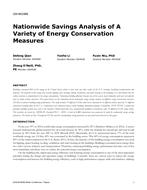Description
Buildings consumed 40% of the energy in the United States, which is more than any other sectors of the U.S. economy, including transportation and industry. The majority of this energy was used for lighting, space heating, cooling, ventilation, and water heating in the buildings. It is well known that the carbon emission is proportional to the energy consumption. Enhancing building efficiency becomes one of the easiest, most immediate and most cost-effective ways to reduce carbon emissions. This paper focuses on the simulation-based nationwide energy savings analysis of different energy conservation measures (ECMs) to enhance building energy performance. The study includes 19 different ECMs, which were simulated in 16 different climate zones for 11 different commercial building types in the U.S. Simulations were conducted using a whole building simulation program, EnergyPlus. DOE PNNL’s commercial prototype building models were used as the baselines. Model input files were automatically modified to incorporate with 19 different ECMs using scripts. The baselines are based on ASHRAE Standard 90.1 – 2010. A total of 4,400 simulations were generated to study the nationwide energy savings potentials. The details of these 19 proposed ECMs and the corresponding saving potentials are presented and discussed in this paper.
Citation: 2018 Winter Conference, Chicago, IL, Conference Papers
Product Details
- Published:
- 2018
- Number of Pages:
- 9
- Units of Measure:
- Dual
- File Size:
- 1 file , 640 KB
- Product Code(s):
- D-CH-18-C005




